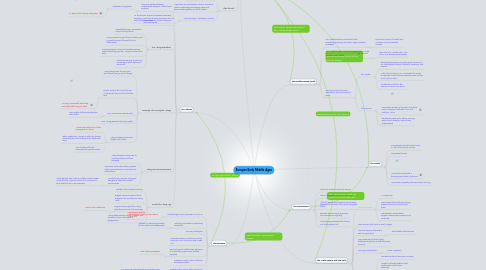
1. The Vikings
1.1. Their war parties attacked Netherlands, Belgium, Ireland and England
1.1.1. Attacked in longships*
1.1.1.1. *A typical 9th century viking ship
1.2. Came from the north looking for riches and glory
1.3. The Viking Reputation
1.3.1. They killed every man,woman, and child they found
1.3.2. Many people thought they had been sent by god to punish the world for its wickedness
1.3.3. Some monarchs and church leaders were so scared that they paid the Vikings to leave their land
1.3.4. Were paid 300 kg of gold and 15,000 kg of silver by French monarchs
1.4. Everyday Life Among the Vikings
1.4.1. Most vikings were farmers and and fishers living in small villages
1.4.2. People lived at the end of fjords* or wherever they could find fertile land
1.4.2.1. * a long, narrow salt water bay with high cliffs along its sides
1.4.3. Men and women shared work
1.4.3.1. Were highly skilled woodworkers and smiths
1.4.4. Free Viking women had many rights
1.4.5. Viking landowners almost always had thralls*
1.4.5.1. * slaves who did much of the heavy work on farms
1.4.5.2. Taken captive by Vikings or sold into slavery because they could not pay their debts and fines
1.4.5.3. The children of thralls automatically became slaves
1.5. Viking Law and Government
1.5.1. They designed many laws to protect people and their property
1.5.2. Laws were not written down; people called Law Speakers memorized and recited them
1.5.3. Usually fined criminals, and gave dangerous offenders harsher punishments
1.5.3.1. Worst penalty was to be an outlaw- to be treated under the law. Anyone could kill an outlaw and be entitled to his or her property
1.6. End of the Viking Age
1.6.1. Ended in the eleventh century
1.6.2. English monarchs gave half of England, the Danelaw, to viking lords
1.6.3. King of France gave the Viking Rollo the province of Normandy*
1.6.3.1. * land of the Northmen
1.6.4. Viking settlements in North America and Greenland were destroyed or disappeared
2. Charlemagne
2.1. Charlemagne came to power in 768 C.E.
2.1.1. *Carolingian Empire- Charlemagne's empire, from about 770 to 814
2.2. Was very interested in rebuilding civilization
2.2.1. Wanted to make things better for the serfs and tradespeople
2.3. Was very intelligent
2.4. Crowned Emperor of the Romans by Pope Leo III on Christmas day in 800 C.E.
2.5. Sent out agents called missi dominici* to make sure people were treated properly
2.5.1. *the lords messengers
2.6. Created a single code of laws for the whole empire
2.7. Defeated the Saxons after a long war and insisted they converted to Christianity
2.7.1. The Saxon leaders refused, so Charlemagne ordered his soldiers to kill 4000 Saxons every day
3. The Romans
3.1. Built great cities with works of art, gardens, arenas, public baths, and theatres
3.2. Were highly literate scholars and poets
3.3. Developed a code of laws
3.3.1. Women, non-Romans and slaves were all denied Roman citizenship
3.4. They admired and borrowed Greek attitudes and learning and made them their own
3.4.1. Admired achievements of the ancient Greeks and they copied and developed their architecture
3.5. The Fall of Rome
3.5.1. In 410 C.E., the civilization of Rome was conquered by the Goths*
3.5.1.1. *a Germanic people
3.6. After the Fall
3.6.1. Accomplishments were lost for centuries after the fall
3.6.2. Ages later, art, architecture, drama, literature, sports, mythology, philosophy, laws, and government systems would be reborn
3.6.3. Went through a 'barbarous' period
3.6.3.1. As the Roman Empire collapsed, Germanic peoples moved into Roman provinces such as Gaul, Britain and Spain
4. The Franks
4.1. Conquered most of Gaul (France) in late 4th/early 5th century
4.2. They were farmers
4.3. Men went armed with a throwing axe called a francisca
4.4. Were fond of jewelry and wore their hair long
5. The Anglo-Saxons and The Celts
5.1. Alfred the Great
5.1.1. An early ruler
5.1.2. Lost many battles with the vikings before he learned how to beat them
5.1.3. Left western and southern England united and prosperous at his death
5.2. Were farmers that lived in small villages
5.3. Men and women shared the work of agriculture
5.3.1. Had skilled metal workers
5.4. Many examples of their highly elaborate sculptures and jewelry have survived
5.5. Were great storytellers
5.5.1. Made ''Beowulf''
5.6. Role of the Irish
5.6.1. Greatest center of learning in Europe
5.6.2. Fought in bloody battles, kept slaves and made human sacrifices
5.6.3. St.Patrick brought Christianity
5.6.4. Large monastery communities became centers for learning for Irish monks and scholars fleeing from Germanic invasions
5.7. Practiced 'Druidism'*
5.7.1. *A practice of nature worship
5.8. Irish Monks
5.8.1. Played a critical role in training missionaries and in spreading Christianity
5.8.2. Travelled through Scotland, England, then Europe spreading knowledge and Christianity
5.8.2.1. Carried their books hooked to their belts
5.8.3. Played an important role in preserving the cultural legacy of ancient Ireland, Greece, and Rome
6. The Mediterranean World
6.1. The Mediterranean environment had everything necessary to sustain large numbers of people
6.1.1. Fertile soil, plenty of rainfall and sunshine, and a moderate climate
6.2. The Mediterranean Sea was a transportation route that encouraged people to travel widely to trade and learn from others
6.2.1. Ideas from the Middle East, Asia, Africa, and Europe spread easily
6.3. Two most important early civilizations were Greece and Rome
6.3.1. The Greeks
6.3.1.1. Studied philosophy and made great advances in art, architecture, drama, literature, medicine, and science
6.3.1.2. In the 4th century B.C.E., Alexander the Great conquered many lands and spread Greek culture as far east as India
6.3.1.3. Weakened and fell to the Romans in about 150 B.C.E.
6.3.2. The Romans
6.3.2.1. The Roman Empire at its peak controlled most of Europe, southeast Asia, and northern Africa
6.3.2.2. Developed systems to deliver running water, road networks, and military organizations
